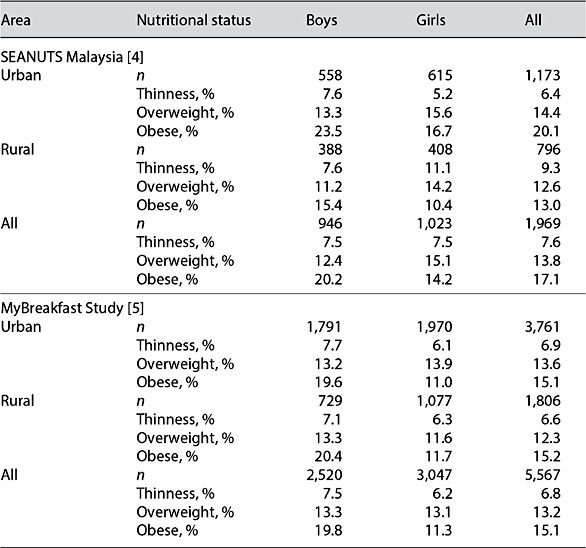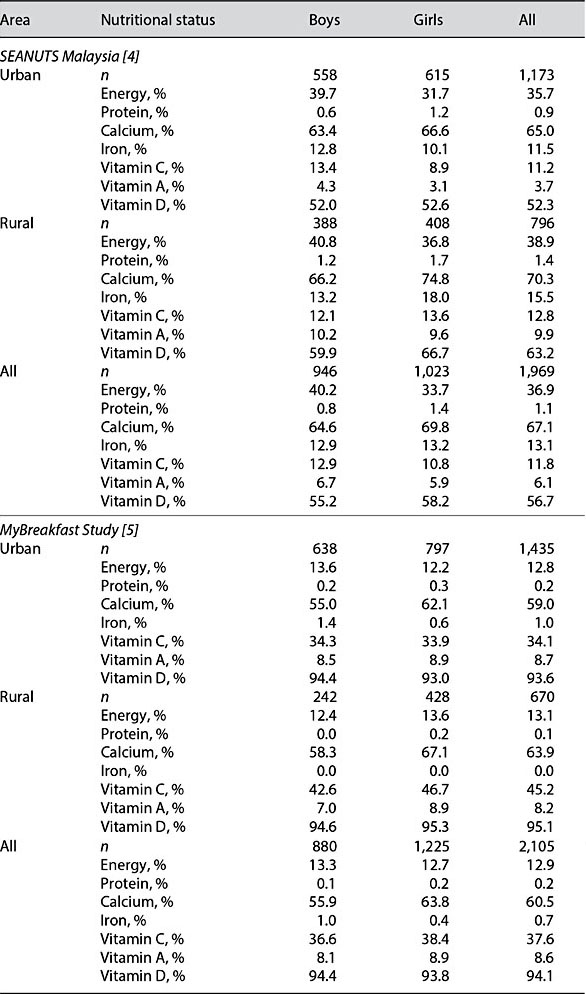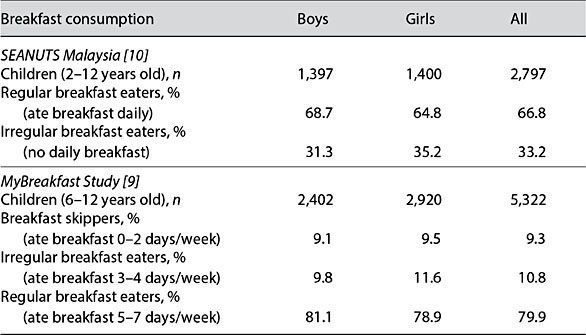Food and Nutrition in Malaysian Children
Food and Nutrition in Malaysian Children
Norimah A. Karim and Nurliyana Abdul Razak
Rapid socioeconomic growth has led to nutrition and health transition in Malaysia. Childhood obesity has become a major concern. The findings from 2 nationwide studies, namely, SEANUTS Malaysia (the South East Asian Nutrition Survey of Malaysian Children) [1] and the MyBreakfast study [2] showed that between 13 and 17% of school children aged between 6 and 12 years were either overweight or obese, with similar prevalence in both urban and rural areas. These studies showed that overweight and obesity problems among Malaysian children should be of concern, as 3 in 10 children are either overweight or obese, irrespective of the areas where they reside.
Table 1 shows the prevalence of children not achieving the recommended nutrient intake (RNI) for selected macro- and micronutrients. The mean energy intake of the children ranged from 1,800 to 1,900 kcal/ day. The majority of the children in both studies (SEANUTS Malaysia [1] and MyBreakfast study [2]) achieved the Malaysian RNI for energy and protein; however, at least two-thirds of the children did not achieve the RNI for calcium. About 9 in 10 children did meet the RNI for vitamin D in the MyBreakfast study [2]. These findings are worrying as both calcium and vitamin D are important nutrients for bone health. In the MyBreakfast study, breakfast was defined as the first eating occasion after an overnight sleep until 10 a.m. on weekdays and 11 a.m. on weekend days [2].
In the MyBreakfast study, the prevalence of breakfast skippers (ate breakfast 0–2 days/week) and irregular breakfast eaters (ate breakfast 3–4 days/week) was 9.3 and 10.8%, respectively, while 79.9% were found to be regular breakfast eaters (ate breakfast 5–7 days/ week) [2]. In the SEANUTS Malaysia, breakfast was defined as the first eating occasion consumed by the children before 10 a.m., and irregular breakfast eaters were defined as children who skipped breakfast on a daily basis [3]. Table 2 shows the distribution of breakfast consumption among primary school children in the SEANUTS Malaysia and the MyBreakfast study.
Table 1. Prevalence of Malaysian primary school children (6–7 to 12 years) not achieving the RNI of selected macronutrients and micronutrients
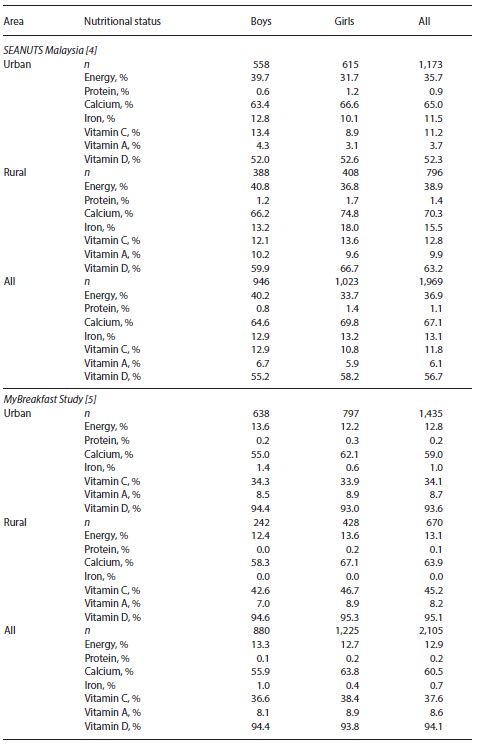
Table 2. Breakfast consumption among primary school children in Malaysia: the SEANUTS Malaysia [10] and MyBreakfast Study [9]
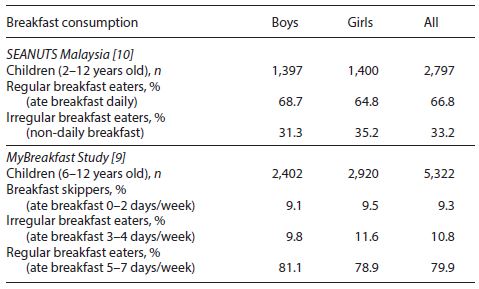
A total of 65.2% of children in the SEANUTS Malaysia consumed breakfast daily. Regular breakfast eaters were found to have higher intake of calcium and vitamins A, C, and D than irregular breakfast eaters [3]. Analysis of 2-day dietary recalls from the MyBreakfast study showed that 17.7% of the children consumed ready-to-eat cereal (RTEC) at breakfast, while among non-RTEC consumers, bread (44.2%), eggs (31.8%) and nasi lemak (23.9%) were the most common foods consumed at breakfast [4]. RTEC was found to be the major contributor of whole grain (68.6%), followed by hot cereal (18.6%), biscuits (8.7%), and bread (1.8%) [5]. It was also shown that only 1.0% of Malaysian children achieved the 43 g/day of whole grain intake recommendation in the Malaysian Dietary Guideline (MDG) for children and adolescents.
In the SEANUTS Malaysia, among children aged 7–9 years (n=890), only 13.4 and 9.5% met the MDG for fruits and vegetables per day, respectively. The pattern was similar among the older children aged 10–12 years (n=883), although slightly higher, whereby only 19.6 and 16.1%, respectively, met the MDG for fruits and vegetables. For the milk group, only very low percentages (5.5%) of children aged 7–9 years and among those aged 10–12 years (3.7%) met the MDG for milk/dairy products [4]. Despite the low milk drinking habits, the MyBreakfast study showed that UHT (ultraheat-treated) milk was commonly consumed at breakfast among RTEC consumers [5]. Thus, the consumption of RTEC at breakfast can promote milk consumption among the children and, subsequently, may increase the prevalence of children meeting the MDG for milk/dairy products.
References
- Poh BK, Ng BK, Siti Haslinda MD, et al: Nutritional status and dietary intakes of children aged 6 months to 12 years: findings of the Nutrition Survey of Malaysian Children (SEANUTS Malaysia). Br J Nutr 2013;110:S21–S35.
- Tee ES, Nurliyana AR, Norimah AK, et al: Breakfast consumption among Malaysian primary and secondary school children and relationship with body weight status – findings from the MyBreakfast Study. Asia Pac J Clin Nutr 2018;27:421–432.
- Chong KH, Wu SK, Hafizah YN, et al: Eating habits of Malaysian children: findings of the South East Asian Nutrition Surveys (SEANUTS). Asia Pac J Public Health 2016;28:59S–73S.
- Koo HC, Poh BK, Lee ST, et al: Are Malaysian children achieving dietary guideline recommendations? Asia Pac J Public Health 2016;28:8S–20S.
- Mohd Nasir MT, Nurliyana AR, Norimah AK, et al: Consumption of ready-to-eat cereals (RTEC) among Malaysian children and association with socio-demographics and nutrient intakes – findings from the MyBreakfast study. Food Nutr Res 2017;61:1304692.
Abstract
Two nationwide studies, namely the South East Asian Nutrition Survey (SEANUTS Malaysia) and MyBreakfast study showed that 13–17% of children aged between 6 and 12 years were either overweight or obese. From dietary assessment, the majority of children achieved the Malaysian recommended nutrient intake (RNI) for energy and protein, but more than 50% did not fulfill the RNI for calcium and vitamin D. The majority of children consumed breakfast regularly; however, 20–30% of children skipped breakfast. The MyBreakfast study showed that 17.7% of the children consumed ready-to-eat cereal (RTEC) at breakfast, while among non-RTEC consumers, bread (44.2%), eggs (31.8%), and nasi lemak (23.9%) were the most common foods consumed. RTEC was the major contributor of whole grain (68.6%), followed by hot cereal (18.6%), biscuits (8.7%), and bread (1.8%). In the SEANUTS Malaysia, among children aged 7–9 years, 13.4 and 9.5% met the Malaysian Dietary Guideline (MDG) for fruits and vegetables while among children aged 10–12 years, only 19.6 and 16.1%, respectively, met the MDG for fruits and vegetables. For the milk group, only 5.5% of 7- to 9-year-old children and 3.7% of those 10–12 years old met the MDG for milk/dairy products per day.
Introduction
Malaysia is a developing country that has been experiencing rapid socioeconomic growth over the last decades, resulting in marked improvement in life expectancy, educational attainment, and income [1]. Rapid socioeconomic growth has also led to changes in dietary habits and lifestyle, and thus the morbidity and mortality pattern of the population [1]. Food availability from animal products as well as sugar and sweeteners has increased by 82 and 70%, respectively, between the year 1967 and 2007 [2]. Rice is a staple food for Malaysians, but energy contribution from rice has decreased from 1,176 to 731 kcal/day between 1970 and 2009 [3]. Changing trends in the dietary pattern of Malaysians have been associated with the increasing prevalence of obesity and noncommunicable diseases in this country [1–3].
Childhood obesity has become a major concern as the prevalence has in- creased over the years. In this paper, we will discuss the findings on nutritional status, nutrient intake, and food habits – in particular the breakfast habits of Malaysian primary school children. Results from 2 nationwide cross-sectional studies, namely the South East Asian Nutrition Survey of Malaysian Children (SEANUTS Malaysia) [4] and the MyBreakfast study [5], will be discussed. The SEANUTS Malaysia was conducted in 2010–2011, involving 3,542 children aged 0.5–12 years, with 1,969 of them from the primary school aged between 7 and 12 years [4]. The MyBreakfast study was conducted in 2013, with 8,705 children aged 6–17 years participating in the study, of whom 5,581 were primary school children aged between 6 and 12 years [5]. Both SEANUTS Malaysia and the MyBreakfast study included urban and rural children from all regions of the country, namely, Central, Southern, Northern, East Coast, and East Malaysia regions.
Table 1. Nutritional status of Malaysian primary school children aged 6–12 years
Nutritional Status of Malaysian Children
In both SEANUTS Malaysia [4] and the MyBreakfast study [5], the nutritional status of the children was determined using WHO Growth Reference 2007 [6]. Table 1 shows the distribution of the nutritional status of children in the SEA- NUTS Malaysia [4] and the MyBreakfast study [5]. Among the children in SEA- NUTS Malaysia, the prevalence of overweight was higher (14.4%) in urban than rural (12.6%) areas. Similarly, the prevalence of obesity was also higher (20.1%) in urban than rural (13.0%) areas [4]. In the MyBreakfast study, the overall prevalence of overweight and obesity among primary school children was 13.2 and 15.1%, respectively [5]. In the analysis by area, the MyBreakfast study showed that the prevalence rates of overweight and obesity among the children were similar in both urban (13.6% overweight; 15.1% obesity) and rural areas (12.3% overweight; 15.2% obesity). The results from both SEANUTS Malaysia [4] and the MyBreakfast study [5] showed that overweight and obesity among Malaysian children should be of concern as 3 in 10 children were either overweight or obese irrespective of areas where they reside.
Nutrient Intake of the Children in Malaysia
In SEANUTS Malaysia, the mean energy intakes of the children in urban and rural areas were 1,978 and 1,939 kcal/day, respectively [4]. Similarly, in the My- Breakfast study [5], the mean energy intake of children in the rural area (1,779 kcal) was not very different from their counterparts in the urban area (1,814 kcal).
Table 2 shows the prevalence of children not achieving the RNI of selected macro- and micronutrients in the SEANUTS Malaysia [4] and the MyBreakfast study [5]. The majority of the children in both studies achieved the Malaysian RNI for energy and protein. However, at least two-thirds of the children did not achieve the RNI for calcium for both studies. About 9 in 10 children did meet the RNI for vitamin D in the MyBreakfast study. Hence, these 2 nutrients are of major concern in Malaysia. These findings are worrying, as both calcium and vitamin D are important nutrients for bone health. A recent report from the SEANUTS Malaysia showed that only a very low percentage of children aged 7–9 years (5.5%) and 10–12 years (3.7%) met the Malaysian Dietary Guideline (MDG) for milk/dairy products per day [7]. As milk consumption is not a habit in Malaysia, a lot more concerted effort is needed to promote milk drinking habits especially among the Malaysian children. Geographically, Malaysia is in the equator, with the sun shining almost every day of the year. Since the children were not able to get dietary vitamin D, it is imperative that the children are encouraged to be outside in the sun, so that vitamin D can be synthesized in the body.
Table 2. Prevalence of Malaysian primary school children (6–7 to 12 years) not achieving the recommended nutrient intake of selected macronutrients and micronutrients
Food Habits of Malaysian Children
Breakfast consumption has been shown to benefit children’s body weight status, nutrient profiles, and cognitive performance [8]. The MyBreakfast study was the first comprehensive nationwide study on breakfast habits among school children in Malaysia [5]. In this study, breakfast was defined as the first eating occasion after an overnight sleep until 10 a.m. on the weekdays and 11a.m at the weekends [5, 9]. Among the children who had completed the Break- fast Habits Questionnaire and anthropometric measurements in the MyBreakfast study, the prevalence of breakfast skippers (ate breakfast 0–2 days/week) and irregular breakfast eaters (ate breakfast 3–4 days/week) was 9.3 and 10.8%, respectively, while 79.9% were found to be regular breakfast eaters (ate break- fast 5–7 days/week) [9]. In the SEANUTS Malaysia, breakfast was defined as the first eating occasion consumed by the children before 10 a.m., and irregular breakfast eaters were defined as children who skipped breakfast on a daily basis [10]. Table 3 shows the distribution of breakfast consumption among primary school children in the SEANUTS Malaysia and the MyBreakfast study.
Only 65.2% of children in the SEANUTS Malaysia consumed breakfast daily [10]. In the MyBreakfast study, children who consumed breakfast regularly were found to have healthier body weight status and were less likely to become over- weight or obese than children who skipped breakfast [9]. Regular breakfast eaters were also found to have higher intake of calcium and vitamins A, C, and D than irregular breakfast eaters [10]. Analysis of the 2-day 24-h dietary recall data of the MyBreakfast study showed that 17.7% of the children consumed ready- to-eat cereal (RTEC) at breakfast, while among non-RTEC consumers bread (44.2%), eggs (31.8%), and nasi lemak (23.9%) were the most common foods consumed at breakfast [11]. RTEC was found to be the major contributor of whole grain (68.6%), followed by hot cereal (18.6%), biscuits (8.7%), and bread (1.8%) [12]. It was also shown that only 1.0% of Malaysian children achieved the MDG for whole grain intake [12].
In the SEANUTS Malaysia, it was found that among children aged 7–9 years (n = 890), only 13.4 and 9.5% met the MDG for fruits and vegetables per day, respectively [7]. The pattern was similar among the older children aged 10–12 years (n = 883) although slightly higher; only 19.6 and 16.1%, respectively, met the MDG for fruits and vegetables per day. For the milk group, a very low percentage of children aged 7–9 years (5.5%) and 10–12 years (3.7%) met the MDG for milk/dairy products per day [7]. Despite this low milk drinking habits, the MyBreakfast study showed that UHT (ultraheat-treated) milk was commonly consumed at breakfast among RTEC consumers [11]. Thus, the consumption of RTEC at breakfast can promote milk consumption among the children and sub- sequently may increase the prevalence of children meeting the MDG for milk/ dairy products.
Table 3. Breakfast consumption among primary school children in Malaysia: the SEANUTS Malaysia [10] and the MyBreakfast Study [9]
Conclusion
Childhood obesity has increased at an alarming rate in Malaysia; thus, the problem is still a major concern. On average, children in Malaysia consumed between 1,800 and 1,900 kcal/day, and the majority of the children achieved the RNI for energy and protein. However, nutrients not meeting the RNI for a majority of the children were calcium and vitamin D. Although a majority of the children consumed breakfast regularly, there were still 1 in 5 children who skipped their breakfast. Food groups which were not meeting the MDG were milk, fruits, and vegetables. Milk and dairy products as well as fruits and veg- etables were not habitually eaten daily; hence, only 1 in 20 children met the MDG for milk while 1 in 10 achieved the MDG for fruits and vegetables. With the lack of calcium and vitamin D in the diet, the habit of milk and dairy product consumption should be inculcated at breakfast. Similarly, fruit and vegetable intake can be improved at mealtimes particularly during lunch and dinner and as healthy snacks.
References
-
1 Noor MI: The nutrition and health transition in Malaysia. Public Health Nutr 2002;5:191– 195.
-
2 Khor GL: Food availability and the rising obesity prevalence in Malaysia. IeJSME 2012; 6(suppl 1):S61–S68.
-
3 Soon JM, Tee ES: Changing trends in dietary pattern and implications to food and nutrition security in Association of Southeast Asian Nations (ASEAN). Int J Nutr Food Sci 2014;3:259–269.
-
4 Poh BK, Ng BK, Siti Haslinda MD, et al: Nutritional status and dietary intakes of children aged 6 months to 12 years: findings of the Nutrition Survey of Malaysian Children (SEA- NUTS Malaysia). Br J Nutr 2013;110:S21–S35.
-
5 Tee ES, Mohd Nasir MT, Norimah AK, et al: MyBreakfast Study of School Children: Findings, Implications & Solutions. Kuala Lumpur, Nutrition Society of Malaysia, 2015.
-
6 de Onis M, Onyango AW, Borghi E, et al: Development of a WHO growth reference for school-aged children and adolescents. Bull World Health Organ 2007;85:660–667.
-
7 Koo HC, Poh BK, Lee ST, et al: Are Malaysian children achieving dietary guideline recommendations? Asia Pac J Public Health 2016;28:8S–20S.
-
8 Rampersaud GC, Pereira MA, Girard BL, et al: Breakfast habits, nutritional status, body weight, and academic performance in children and adolescents. J Am Diet Assoc 2005; 105:743–760.
-
9 Tee ES, Nurliyana AR, Norimah AK, et al: Breakfast consumption among Malaysian primary and secondary school children and relationship with body weight status – findings from the MyBreakfast Study. Asia Pac J Clin Nutr 2018;27:421–432.
-
10 Chong KH, Wu SK, Hafizah YN, et al: Eating habits of Malaysian children: findings of the South East Asian Nutrition Surveys (SEA- NUTS). Asia Pac J Public Health 2016;28: 59S–73S.
-
11 Mohd Nasir MT, Nurliyana AR, Norimah AK, et al: Consumption of ready-to-eat cereals (RTEC) among Malaysian children and association with socio-demographics and nu- trient intakes – findings from the MyBreakfast study. Food Nutr Res 2017;61:1304692.
-
12 AK N, Koo HC, Jm HJ, et al: Whole grain intakes in the diets of Malaysian children and adolescents – findings from the MyBreakfast Study. PLoS One 2015;10:e0138247.
